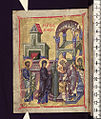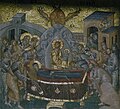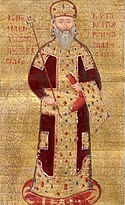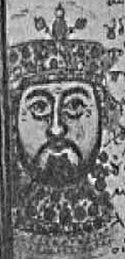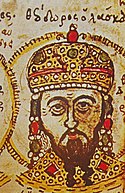Renesans Paleologów
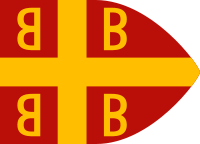
Renesans Paleologów – okres rozwoju kultury bizantyńskiej, przypadający na panowanie dynastii Paleologów, czyli lata 1261–1453. Był to czas rozkładu Cesarstwa Bizantyńskiego pod względem politycznym, jednak pod kątem sztuki panował rozkwit[1].
Literatura
Za panowania Paleologów nastąpił rozwój literatury w tym także tej historycznej. Najważniejszymi historykami byli wówczas Jerzy Pachymeres, Nikefor Gregoras i Jan VI Kantakuzen. Pachymeres jest autorem Historii zakończonej na roku 1308 i dobrze opisującej rządy Michała VIII oraz jego syna Andronika II. Gregoras z kolei napisał dzieło zatytułowane Romaike historia, czyli "Historia rzymska", opisujące lata 1204-1359[2]. Nie dość że ostatnie czterdzieści lat jest przedstawionych bardzo szczegółowo, to Gregoras dodatkowo wyróżnia się wyjątkową bezstronnością w większości aspektów. Jan Kantakuzen stworzył Historie opiewające czterdzieści lat od 1320 roku. Problem tego dzieła tkwi w tym, iż Kantakuzen jako cesarz w latach 1341-1354 sam był bohaterem jednej trzeciej omawianego przez siebie okresu. To z kolei nadaje Historiom subiektywny charakter, a były władca próbuje w nich postawić siebie w jak najlepszym świetle[3].
Inną wybitną postacią był Nikefor Chumnos, piastujący wysokie urzędy publiczne i powiązany z rodem Paleologów. Chumnos napisał różne traktaty filozoficzne i teologiczne, gdzie przeciwstawił teorię Arystotelesa neoplatonizmowi. Oprócz tego zajmował się astronomią, matematyką, oraz retoryką. W imieniu cesarza Andronika II redagował akty prawne, między innymi edykt o reformie sądownictwa z 1296 oraz złotą bullę z 1313 roku[4]. Liczne traktaty retoryczne, filologiczne i teologiczne pozostawił po sobie filolog Tomasz Magister. Jego dzieła O władzy cesarskiej, oraz O państwie dostarczają istotne informacje o systemie administracyjnym Andronika II. Na dworze w Konstantynopolu u Andronika następcą Chumnosa na stanowisku mesadzona był Teodor Metochita, twórca traktatów filozoficznych, matematycznych, astronomicznych, lecz ponadto udzielający się w poezji i retoryce. Wśród poetów zaznaczyli się również Manuel Holobol, a także Manuel Files. Wybitnym filozofem połowy XIV wieku był neoplatończyk Demetriusz Kydones z Tesaloniki. Brał on udział w żarliwych dysputach religijnych jako przeciwnik mistycznego ruchu hezychazmu, oraz zajmował stanowisko prozachodnie, dążące do zjednania Kościołów prawosławnego i katolickiego. Demetriusz zasłynął jako tłumacz z łaciny na grekę wielu dzieł zachodnich w tym między innymi Summa theologiae świętego Tomasza z Akwinu[5].
Sprawami społecznymi zajmowali się Mikołaj Kabazylas, autor traktatów o lichwiarstwie, czy Aleksy Makrembolita, który napisał Dialog między bogaczem a żebrakiem[6]. Wśród cesarzy obok Jana Kantakuzena w dziedzinie literatury należy postawić Manulea II, autora traktatów teologicznych, pism okolicznościowych, czy też wielu listów. Na temat unii kościołów pisali tacy uczeni jak humanista Jerzy Gemist-Pleton, Marek Eugenik, Gennadiusz II Scholar, albo Jan Eugenik. O życiu dworskim i systemie administracyjnym informuje praca o urzędach pałacowych i kościelnych. Dzieło to powstałe za Jana Kantakuzena informuje o zwyczajach na cesarskim dworze, na przykład koronacji cesarza, oraz przedstawia wykaz urzędów kościelnych i świeckich[7]. W dziedzinie prawa duże znaczenie ma wydany w 1345 Heksabiblos Konstantyna Hermenopula stanowiący kompendium o prawie karnym i cywilnym. Został napisany na podstawie dawnych kodeksów bizantyńskich, między innymi Prochironu a także Eklogi. Heksabiblos szeroko rozpowszechnił się poza Bizancjum.
Architektura
Kościół świętego Zbawiciela w Mykonos
Plan Chory w Konstantynopolu
Dzwonnica Hagia Sophia w Trabzonie
Kościół św. Jana w Ochrydzie
Monastyr Gračanica w Gračanicy
Malarstwo
Ikony i freski
Maria z Nazaretu z Jezusem i apostołami dookoła
Wskrzeszenie Łazarza z XIV wieku
Ikona Chrystusa z Ochrydy z początku XIV wieku
Czternastowieczna ikona przedstawiająca św. Klemensa
Zwiastowanie z XIV wieku
Sąd ostateczny na sklepieniu Chory
- © José Luiz Bernardes Ribeiro/CC-BY-SA-3.0
Święty Dymitr Sołuński
Freski przedstawiające patriarchów z wnętrza Chory
- (c) User: Bgabel z wikipodróże shared, CC BY-SA 3.0
Freski Monastyru Pantanassa
Freski na kopule Pantokratora w Monastyrze Pantanassa
Wyszydzenie Jezusa z Kościoła Świętego Krzyża na Cyprze
Iluminacje
Portret Dionizego Areopagity z XV wieku
Iluminacja z kroniki Jerzego Mnicha
Menologion[a] despoty Demetriusza II
Historia Aleksandra Wielkiego z XIV wieku
Manuel II, jego żona Helena Dragasz i dzieci
Wizerunek megaduksa Aleksego Apokauka w stroju urzędowym
Jan VI Kantakuzen obecny na synodzie w 1351
Mozaiki
- © José Luiz Bernardes Ribeiro, CC BY-SA 3.0
Mozaika z Chory
Mozaika na kopule kościoła Chora przedstawiająca Theotokos
- © José Luiz Bernardes Ribeiro, CC BY-SA 3.0
Paweł Apostoł na mozaice z Chory
Święty Jerzy na mozaice
Wizerunki cesarzy
Rzeźba
Rzeźba Jana Chrzciciela
Zobacz też
- Upadek Cesarstwa Bizantyńskiego
- Monachomachia w Bizancjum
- Ikonoklazm w Bizancjum
- Kryzys dynastyczny w Bizancjum z przełomu VII i VIII wieku
- Wieki ciemne w Cesarstwie Bizantyńskim
- Stratioci
- Renesans Komnenów
- Laonik Chalkokondyles
Uwagi
- ↑ Menologion to w liturgii greckiej księga zawierająca żywoty świętych ułożone w porządku poświęconych im dni.
Przypisy
- ↑ Gregorij Ostrogorski, Dzieje Bizancjum, Wydawnictwo Naukowe PWN, Warszawa 2008, s. 447.
- ↑ Gregorij Ostrogorski, Dzieje Bizancjum, Wydawnictwo Naukowe PWN, Warszawa 2008, s. 436.
- ↑ Gregorij Ostrogorski, Dzieje Bizancjum, Wydawnictwo Naukowe PWN, Warszawa 2008, s. 437.
- ↑ Gregorij Ostrogorski, Dzieje Bizancjum, Wydawnictwo Naukowe PWN, Warszawa 2008, s. 441.
- ↑ Gregorij Ostrogorski, Dzieje Bizancjum, Wydawnictwo Naukowe PWN, Warszawa 2008, s. 442.
- ↑ Gregorij Ostrogorski, Dzieje Bizancjum, Wydawnictwo Naukowe PWN, Warszawa 2008, s. 443.
- ↑ Gregorij Ostrogorski, Dzieje Bizancjum, Wydawnictwo Naukowe PWN, Warszawa 2008, s. 444.
Bibliografia
- Georgij Ostrogorski : Dzieje Bizancjum, przekład pod redakcją Haliny Evert-Kappesowej. Warszawa: Wydawnictwo Naukowe PWN, 2008.
Media użyte na tej stronie
Autor: Nieznany, Licencja: CC BY 4.0
Scene from the Lives of Christ and the Virgin, from a Greek Menologion with Byzantine miniatures, badly flaking, made for Demetrios I Palaiologos, despot of Thessalonike 1322-c. 1340. Shelfmark: Bodleian Library MS. Gr. th. f. 1
Isaac II. MS Mutinensis gr. 122 f. 293v
Alexius III. MS Mutinensis gr. 122 f. 293v
Manuel II Palaiologos, Byzantine Emperor from 1391 until his death in 1425.
Autor: Robert Jahoda, Licencja: CC BY-SA 4.0
Pôdorys Chrámu svätého Spasiteľa (Chóra), podľa: Müller-Wiener, Wolfgang, Bildlexikon zur Topographie Istanbuls: Byzantion, Konstantinupolis, Istanbul bis zum Beginn des 17. Jahrhunderts, Wasmuth, 1977, ISBN 9783803010223, s. 151, (zdroj: https://commons.wikimedia.org/wiki/File:HSX_Millingen_1912_fig_105.jpg, https://www.thebyzantinelegacy.com/chora, http://www.guidesinistanbul.com/chora-church/).
Η Παναγία βρεφοκρατούσα με αποστόλους και αγίους μέσα 14ου αιώνα, 71x92εκ. άγνωστος ζωγράφος από την Κωνσταντινούπολη
Στην εικόνα αυτή παριστάνεται μετωπική και μέχρι τη μέση η Παναγία που κρατεί τον Χριστό μπροστά στο στήθος της και με τα δύο χέρια. Ο Χριστός εικονίζεται στη στάση του Αναπεσόντα, που είναι μία συμβολική απεικόνιση του Χριστού και προεικονίζει το Πάθος και την Ανάσταση. Τόσο ο Χριστός σε αυτή τη στάση, όσο και η θλίψη στο πρόσωπο της Παναγίας αποτελούν αναφορά στη σταυρική του θυσία. Στην εικόνα περιλαμβάνονται ακόμη δύο μικροί στηθαίοι άγγελοι, και σε δύο στενές στήλες από κάθε πλευρά οι απόστολοι Πέτρος και Παύλος, οι τέσσερις ευαγγελιστές, ο απόστολος Ανδρέας και οι στρατιωτικοί άγιοι, Θεόδωρος, Δημήτριος και Γεώργιος.Autor: Nieznany, Licencja: CC BY 4.0
Scene from the Lives of Christ and the Virgin, from a Greek Menologion with Byzantine miniatures, badly flaking, made for Demetrios I Palaiologos, despot of Thessalonike 1322-c. 1340. Shelfmark: Bodleian Library MS. Gr. th. f. 1
Emperor Alexios V Doukas
Zoe, Empress regnant of Byzantium
Autor: Dosseman, Licencja: CC BY-SA 4.0
A mosaic of Christ to the left of the apse
Romanus_Lecapenus. MS Mutinensis gr. 122 f. 270r
Autor: wolfgang.mller54 from Niedersachsen /Germany, Licencja: CC BY 2.0
..im Pantanassa Kloster Mystras / Peleponnese
GriechenlandAutor: Alexandrosmp, Licencja: CC BY-SA 4.0
This is a photo of a monument in Greece identified by the ID
(c) User: Bgabel z wikipodróże shared, CC BY-SA 3.0
Fresken in Kirche Kloster Pantanassa, Unterstadt Mystras
Autor: Nieznany, Licencja: CC BY 4.0
Scene from the Lives of Christ and the Virgin, from a Greek Menologion with Byzantine miniatures, badly flaking, made for Demetrios I Palaiologos, despot of Thessalonike 1322-c. 1340. Shelfmark: Bodleian Library MS. Gr. th. f. 1
Autor: Sharon Mollerus, Licencja: CC BY 2.0
Icone: Saint Demetrios, Empire byzantin, end of 14th century
Autor: Autor nie został podany w rozpoznawalny automatycznie sposób. Założono, że to Marsyas (w oparciu o szablon praw autorskich)., Licencja: CC BY-SA 2.5
Mary and her ancestors on the lesser dome of Chora church in Constantinople/Istanbul.
Photograph taken by Marsyas 13:33, 19 January 2006 (UTC)Gordian_I_and_Gordian_II. MS Mutinensis gr. 122 f. 59v
Autor: Original uploader was Ian Pitchford at en.wikipedia, Licencja: CC-BY-SA-3.0
The Holy Savior in Chora. The mosaic in the lunette over the doorway to the esonarthex portrays Christ as "The Land of the Living". The composition reflects the theological and philosophical interpretation of the term, expounded by Theodore Metochites and other scholars of his time (1315-1321).
Autor: Dosseman, Licencja: CC BY-SA 4.0
Looking back to the entrance from the esonarthex, above the door, one sees a "death of Mary". She is seen lying on a bed, as if asleep (hence "dormition"), her soul, swaddled like a baby, is held by her son, Christ. Around stand apostles, evangelists, early bishops. A six-winged seraph hovers over Christ.
Autor: Autor nie został podany w rozpoznawalny automatycznie sposób. Założono, że to Neuceu (w oparciu o szablon praw autorskich)., Licencja: CC BY 2.5
Chora church in Istanbul. South coupole of the esonarthex. Genealogy of Jesus Christ and the Christ Pantocrator.
I feel that this picture is an inspiration to every one to see and hope for the Returm of Christ Jesus our Saviour© José Luiz Bernardes Ribeiro, CC BY-SA 3.0
Mosaico de São Paulo na Igreja de Chora
Autor: Nieznany, Licencja: CC BY 4.0
Scene from the Lives of Christ and the Virgin, from a Greek Menologion with Byzantine miniatures, badly flaking, made for Demetrios I Palaiologos, despot of Thessalonike 1322-c. 1340. Shelfmark: Bodleian Library MS. Gr. th. f. 1
Autor: G.dallorto, Licencja: CC BY-SA 2.5
Istanbul: Museo di San Salvatore in Chora (Kariye Cami) - Parecclesion (cappella funeraria). Abside, affresco raffigurante la Madonna col bambino. Foto di: Giovanni Dall'Orto, 29-5-2006.
Konstantinos IX, Byzantine Emperor
Michael VIII Palaiologos. Miniature from the manuscript of Pachymeres' Historia, 14th century. Munich, Bayerische Staatsbibliothek.
Cropped Image A fourteenth-century miniature Greek manuscript depicting scenes from the life of Alexander the Great. The priests of the Jews (Rabbis) offer Alexander the Great Gold and Silver, Alexander spent the gifts of the Rabbi’s on his Gods. The whole scene is depicted entirely in Byzantine fashion of the late Byzantine period (1204-1453). Alexander the Great is depicted as a Byzantine Emperor (Basileus) and his troops are depicted as Byzantine-Greek soldiers of the 14th century. The Jewish Rabbis (standing to the right) are shown wearing distinctive ceremonial robes and small caps on their heads. From the “Alexander Romance” in S. Giorgio dei Greci in Venice.
Basil. MS Mutinensis gr. 122 f. 184v
Autor: George E. Koronaios, Licencja: CC BY-SA 4.0
STAND A86. Part of an architectural member with representation of Christ Pantocrator, late 13th-14th c. Thebes. Archaeological Museum of Thebes, Thebes, Greece. Text: Museum inscription.
Autor: Shakko, Licencja: CC BY-SA 3.0
"Святой Иоанн Предтеча". Икона резная в оправе.
Византия, XIV - первая половина XV в. Стеатит; серебро; резьба, золочение. Происходит из Благовещенского собора Московского Кремля.
Сохранилось несколько драгоценных мощевиков, проиходящих из Благовещенского собора. По надписям можно предположить, что именно эти святыни привезла София Палеолог. Хранившиеся в них мощи многих святых, очевидно, были привезены из Рима.Byzantinische Doppelikone mit der Hl. Jungfrau Psychosostria (Konstantinopel Anfang des 14 Jh.) Ohrid Ikonenmuseum, Mazedonien
The Byzantine cleric, scholar and historian George Pachymeres (1242 – c. 1310)
Emperor Andronikos II Palaiolgos
© José Luiz Bernardes Ribeiro, CC BY-SA 3.0
Mosaico Deesis ("Súplica") em Chora
The statesman and patron Theodore Metochites presenting a model of the Chora Church to Christ.
Autor: Patrice78500, Licencja: CC BY-SA 4.0
Vue du Pantanassa Monastery - Abside et Narthex
Byzantine Emperor John VI Kantakouzenos presiding over a synod. The Hesychast Council of Constantinople, 1351. Constantinople, 1370-75, paint on parchment, Greek Manuscript 1242, fol.5 v, 33,5x24 cm, Bibliothèque nationale de France, Paris.
Св. Климент Охридски
Autor: Nieznany, Licencja: CC SA 1.0
Leo V the Armenian, emperor of the Byzantine Empire from 813 to 820.
Michael IX Palaiologos (1283-1320) in a miniature portrait from John Zonaras.
Autor: George E. Koronaios, Licencja: CC BY-SA 4.0
Front side of a double-sided icon depicting the Virgin Hodegetria. From Berroia. 13th cent. Accession Number: BXM 985. Byzantine and Christian Museum of Athens. Athens, Greece.
THE RAISING СИ LAZARIS. Late 14th — early 15th Century. Byzantium From the Collection of G. Gamon-Gumun. Russian museum
Autor: Orjen, Licencja: CC-BY-SA-3.0
This is a photo of Cultural Heritage site of Serbia number
Псалтирь, Российская Национальная Библиотека - Санкт-Петербург, греч. 269 (ранее в cod. Sinait. 38), л. 2
Миниатюра:
- Переход через Красное море. Потопление войск фараона
Autor: Dosseman, Licencja: CC BY-SA 4.0
Mary with Child (the theme is called Hodegetria) to the right of the apse.
Saint George and the Dragon, Byzantine portable mosaic.
Andronicus I. MS Mutinensis gr. 122 f. 293v
Autor: Nieznany, Licencja: CC BY 4.0
Page from a cycle for St. Demetrios, from a Greek Menologion with Byzantine miniatures, badly flaking, made for Demetrios I Palaiologos, despot of Thessalonike 1322-c. 1340. Shelfmark: Bodleian Library MS. Gr. th. f. 1
Emperor John VII Palaiologos
Constantine XI Palaiologos, the last Byzantine Emperor
Manuel. MS Mutinensis gr. 122 f. 293v
Miniature of Romanos III.
Autor: Jakub Fryš, Licencja: CC BY-SA 4.0
Church of St. John at Kaneo, Ohrid, Macedonia
Alexander poisoned, Hellenic Institute codex 5 f. 189v top (Alexander Romance recension gamma)
Emperor Mauricius of Byzantium (582-602)
Autor: G.dallorto, Licencja: CC BY-SA 2.5
Istanbul: Museo di San Salvatore in Chora (Kariye Cami) - Parecclesion (cappella funeraria). Abside affrescato. Foto di: Giovanni Dall'Orto, 29-5-2006.
© José Luiz Bernardes Ribeiro/CC-BY-SA-3.0
pt:Demétrio de Tessalônica (Demetrius of Thessaloniki).
The international exhibition in the en:Paris in 1961, The fresco "Holy Mother of God" was proclaimed the most beautiful fresco of the entire Middle Age.
Autor: Gregor Hagedorn, Licencja: CC BY-SA 4.0
Despot's Palace (Mystras, Greece, 2017)
Η Εις Άδου Κάθοδος τέλη 14ου αιώνα, 47,2x62εκ. άγνωστος ζωγράφος από την Κωνσταντινούπολη
Η εικόνα παρουσιάζει την Ανάσταση του Χριστού, η οποία στη βυζαντινή τέχνη αποδίδεται με την Κάθοδο του Χριστού στον Άδη, σύμφωνα και με το απόκρυφο ευαγγέλιο του Νικοδήμου. Ο Χριστός στο κέντρο, μέσα σε δόξα, και μπροστά από μεγάλη σπηλιά, πατάει στις πύλες του Άδη και ανασηκώνει από την ανοιχτή σαρκοφάγο τον Αδάμ. Πίσω από τον Αδάμ στέκονται η Εύα, προφήτες και δίκαιοι και από την άλλη πλευρά ο Πρόδρομος, ο Σολομών, ο Δαβίδ και άλλοι προφήτες βασιλείς από την Παλαιά Διαθήκη. Χαμηλά στο κέντρο ένας άγγελος αλυσσοδένει τον Άδη. Επάνω στο χρυσό βάθος δύο άγγελοι πετούν, κρατώντας τα σύμβολα του Πάθους και αριστερά, πίσω από τον βράχο προβάλλει ο προφήτης Ιωνάς.Miniature of Byzantine Emperor Michael V.
Byzantine icon of the Annunciation
Благовещение. Неизвестный мастер, Византия, XIV век. Вторая четверть - середина XIV века. дерево (слева утрачена, ковчег), паволока, темпера, позолота. ГМИИ. 55х43 см. Ж-2860. Атрибуция и датировка О. Е. Этингоф; В. Н. Лазарев связывал с Константинополем и относил к первой четверти XIV века; Е. Я. Осташенко — к началу столетия.
Архимандритом Павлом (Прусским) привезена из Иерусалима; с 1887 в Никольском монастыре, Москва; с 1917 в ГИМ; с 1933 в ГМИИ.Alexius II. MS Mutinensis gr. 122 f. 293v
Autor: Takeaway, Licencja: CC BY-SA 3.0
Dome of the parecclesion (Chora Church)
Constantine_the_Great. MS Mutinensis gr. 122 f. 74v
Autor: Tilemahos Efthimiadis from Athens, Greece, Licencja: CC BY-SA 2.0
Byzantine and Christian Museum, Athens, Greece. --- Μαρμάρινα αγαλματάκια της Παναγιάς Βρεφοκρατούσας, δυτικής τέχνης. 14ος αι.
Βυζαντινό και Χριστιανικό Μουσείο, Αθήνα.Autor: Aeleftherios, Licencja: CC BY-SA 3.0
Frankish palace of Mystras (detail)
Jesus between Mikhail Yaroslavich and his mother Oxinia, miniature, Chronicle of Georgios Hamartolos, Russian State Library, F. 173, fol. 17v
External links:
Autor: Кардам, Licencja: CC BY-SA 4.0
Michael VIII Palaiologos (1223-1282) in a miniature portrait from John Zonaras.
Autor: User:Vmenkov, Licencja: CC BY-SA 3.0
Pammakaristos Church.
The Synaxis of the holy and the most praiseworthy Twelve Apostles
Miniature of Empress Theodora Porphyrogenita.
Christ, mid XIV Century, St Mary Perivleptos Church, Ohrid Icon Gallery
Christ Psychosostis, Early XIV Century, St Mary Perivleptos Church, Ohrid Icon Gallery
Fresko Mocking of Jesus Holy Cross Church in Platanissa, Cyprus
Autor: Sailko, Licencja: CC BY 3.0
Byzantine art in the Cleveland Museum of Art
Autor: Cplakidas, Licencja: CC BY-SA 3.0
The Byzantine imperial ensign (βασιλικόν φλάμουλον), as depicted in the 14th-century Castilian Book of All Kingdoms, and described in the Treatise on Offices by the mid 14th-century Byzantine writer Pseudo-Kodinos as being hoisted on imperial naval vessels. It features the tetragrammic cross with the four "B"s that is attested in contemporary portolans, on coins and reliefs.
John II. MS Mutinensis gr. 122 f. 293v
Autor: Jean-Paul MOUREZ, Licencja: CC BY-SA 4.0
Coupole et Pantocrator de l'église Panaghia Parigoritissa à Arta (Épire)
А miniature from the Louvre MS. Ivoires 100 manuscript, depicting the Byzantine emperor Manuel II Palaiologos, empress Helena and three of their sons - the co-emperor John VIII and the Despots Theodore and Andronikos.
14th-century miniature of Constantine VIII.


















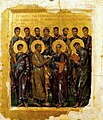














![Menologion[a] despoty Demetriusza II](http://upload.wikimedia.org/wikipedia/commons/thumb/e/e5/Bodleian_Library_MS._Gr._th._f._1_1v.jpg/95px-Bodleian_Library_MS._Gr._th._f._1_1v.jpg)


